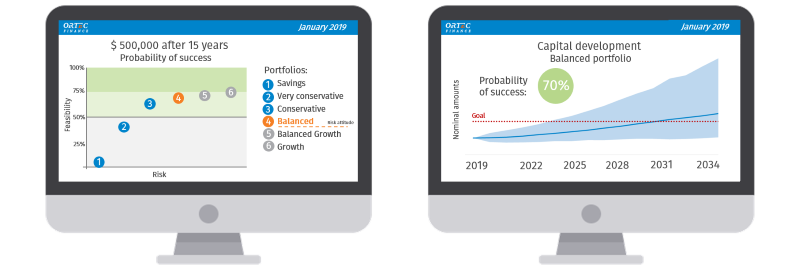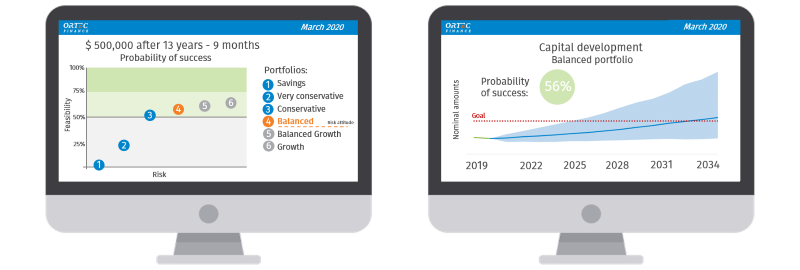Am I OK? Can I still achieve the financial goals that I planned a while ago? Should I withdraw from a possible bear market? Nowadays, financial advisors, investment counselors and wealth managers are most likely receiving countless calls with similar questions from their clients. Market volatility is very high, and it remains uncertain whether markets will calm down or whether this turbulence will continue for a long time.
In our previous blog, we explained how monitoring of client goals can help answer the questions mentioned above. In this blog, we demonstrate how this might look like from a more practical point of view.
Make robust investment decisions in the first place
Suppose you are a retail client at the end of 2018. Together with your advisor, you are building an investment plan to ensure a certain amount of capital for retirement. Currently, your portfolio amounts to $250,000 and you are contributing $500 on a monthly basis. Your goal is to retire in 15 years and your planner has estimated that you would need at least $500,000 to supplement your retirement income until the age of 85. Now it is time to decide which portfolio model is most suitable to help you achieve this goal.
A useful tool to support investment decisions is a scenario analysis. This type of analysis uses realistic projections of risk and return and allows the advisor to demonstrate how several portfolio models compare in terms of the likelihood of achieving the client’s goal. In this case, your advisor shows you that a balanced portfolio leads to a probability of success of at least 70%. A riskier portfolio will just slightly increase this probability, so the additional value in terms of a risk-return trade-off is limited. In addition, a riskier portfolio might be restricted due to the maximum risk willingness of the client, based on the risk questionnaire.

Monitor goals with up-to-date portfolio and market data
Now, fast forward to the end of March 2020. The COVID-19 outbreak generated turbulence in financial markets. A majority of global stock markets are coping with large losses. What does this mean for your portfolio? In the client portal, you can see that the balance of your portfolio has fallen below the initial $250,000. Because of this, you are considering turning your back to the madness of the market. However, when you call your advisor to discuss the current market situation and how this might affect your plan, he offers some refreshing insights. Your advisor can show you - based on the most recent account balance, portfolio allocation, remaining time horizon and latest economic outlook - that you still have a fair chance of achieving your initial goal. Moreover, he can illustrate that if you would immediately transfer your portfolio model to a Very Conservative or even Cash portfolio, the likelihood of reaching your goal would even drop far below 50%. As a consequence, you would have to adjust your goals. Based on your preferences and emotions, you might convert to a less risky Conservative portfolio. However, even though the probability of success is just above 50%, this portfolio is less likely to achieve your long-term goals than your current portfolio.

Tools that support projections of client portfolios, based on up-to-date portfolio and market data, help advisors to support their clients in making robust investment decisions. Without goal monitoring tools, clients may act based on their ‘gut feeling’ and possibly, unnecessarily, deviate from their original plan.
What to do when there is an ‘off track’ situation?
In contrast to the situation sketched above, there is a possibility that the update of the goal feasibility leads to less positive news for the client. Using the same tools, the advisor can propose several options on how to get the plan ‘back on track’. Depending on the client’s situation, they could increase their monthly deposits, delay their planned retirement date or adjust the portfolio model. With automated suggestions, this advice process can be implemented efficiently, enabling the advisor to proactively call all clients that find themselves in an ‘off track’ situation. This is not only efficient, but clients will also appreciate the pro-active approach. After all, that is one of the benefits clients expect, given the relatively higher fees they pay compared to a robo- or execution-only investment platform.
A tool that helps you answer the relevant client questions
The current market conditions, have led to an increased number of clients that worry about whether they can still meet their goals. However, a possible ‘off track’ situation might occur at any moment during the lifespan of an investment plan. Therefore, it is important to conduct a similar kind of health check, as discussed in this article, on a frequent basis. You will not know, beforehand, when an intervention is necessary. This is why having a dashboard, with information to signal possible problems, is vital. As described in our previous blog, with goal monitoring, advisors can have a real-time overview of whether their clients are on- or off track. If a client calls with any of the questions mentioned before, as an advisor, you have the necessary information to assess the situation and guide the client with relevant and concrete options to stay on track.
Contact











